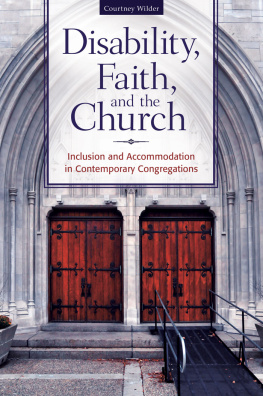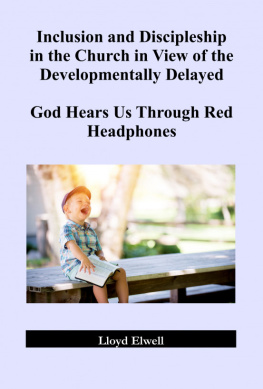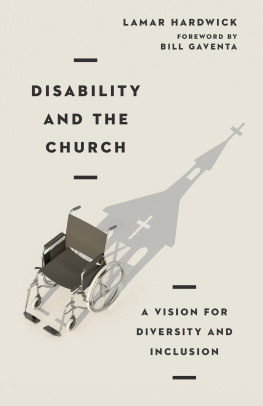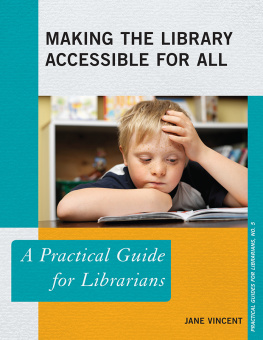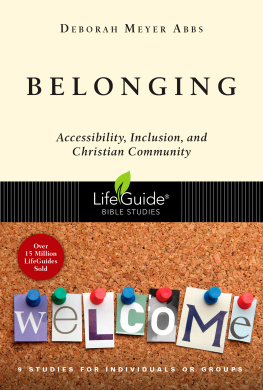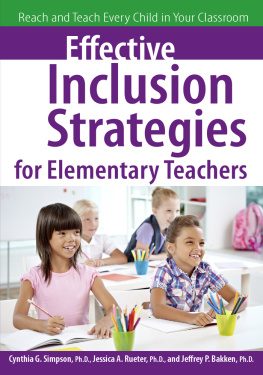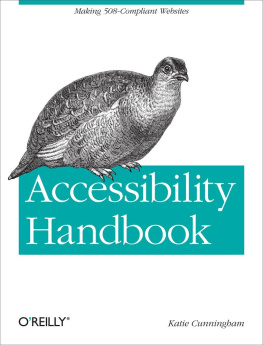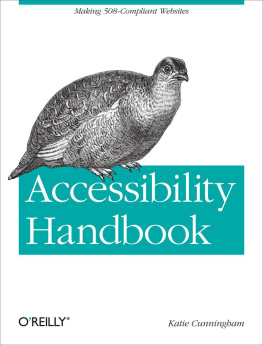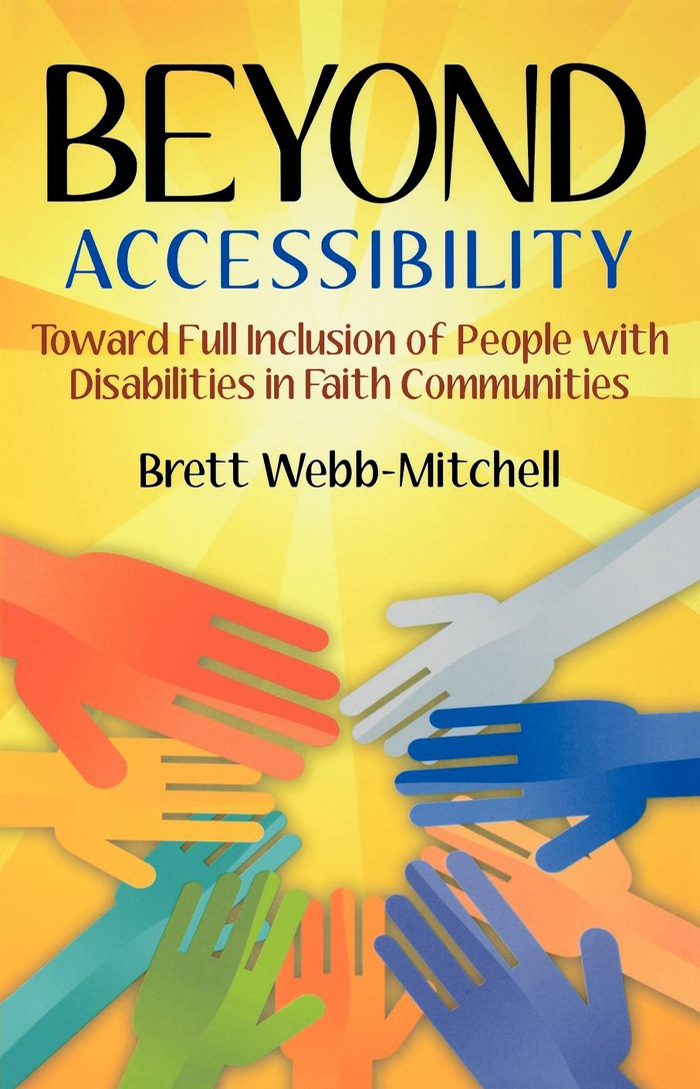BEYOND
ACCESSIBILITY
BEYOND
ACCESSIBILITY
Toward Full Inclusion of People with
Disabilities in Faith Communities

Brett Webb-Mitchell

2010 by Brett Webb-Mitchell
All rights reserved.
Unless otherwise noted, the Scripture quotations contained herein are from the New Revised Standard Version Bible, copyright 1989 by the Division of Christian Education of the National Council of Churches of Christ in the U.S.A. Used by permission. All rights reserved.
Cover design by Christina Moore/Laurie Klein Westhafer
Typeset by Beth Oberholtzer
Library of Congress Cataloging-in-Publication Data
Webb-Mitchell, Brett.
Beyond accessibility : toward full inclusion of people with disabilities in faith communities / Brett Webb-Mitchell.
p. cm.
Includes bibliographical references.
ISBN 978-0-89869-641-7 (pbk.)
1. Church work with people with disabilities. I. Title.
BV4460.W4275 2010
261.8'321-dc22
2010000023
Church Publishing, Incorporated.
445 Fifth Avenue
New York, New York 10016
www.churchpublishing.org
5 4 3 2 1
To the people in all faith communities
who share a vision of the Church as the fully inclusive body of Christ,
a place and people for and of all Gods people.

CONTENTS

ACKNOWLEDGMENTS
This book came about many years after I wrote Dancing with Disabilities. I thought I had written my last book or paper on people with disabilities with that book. Then a few years ago, the Rev. Peter Sulyok, then the director of the Advisory Committee on Social Witness Policy (ACSWP) of the Presbyterian Church (USA) asked me to be the writer of, and a consultant on, a project to formulate a new policy for the denomination on issues facing people with disabilities in the Church and world. Sitting with my friend the Rev. Dr. Trace Haythorn over breakfast at one of the Committee meetings, Peter challenged the members of the Committee to write a policy that would be the last one that needed to be written because full inclusion of people with disabilities would be the goal, and after full inclusion, what else would there be to do? Not only that, this paper was to be a social witness policy not only to the Church, but to the world. Believing that life is a process, a journey, a pilgrimage, I understand now that while the paper I worked on for and with the Presbyterian Church (USA) was a next step toward advocating accessibility and acceptance of people with disabilities in the Church, the paper fell short of mapping a way forward toward full inclusion.
This book hopefully challenges the reader and the Church toward considering the next step, the next move, in the Churchs pilgrimage toward being and becoming fully inclusive of all people who are called and desire to be part of a faith community. Beyond Accessibility is a book that challenges and celebrates the many ways that faith communities are or are becoming more totally inclusive of all Gods people.
I want to thank all the individual people and faith communities whose stories are in this book, making it almost a book of narratives rather than a theological text. Many thanks to Rich Dethmers of Henderson, North Carolina, whose story opens this book poignantly and honestly. I met Rich when I was interim pastor of First Presbyterian Church, Henderson, NC when Elder Phil Hanny and I went to visit a shut-in. What blossomed was a friendship that eclipsed a pastor to shut-in relationship. I am also honored by all of the people who shared their stories and lives unaware that I was listening and watching at the time, from my time in the LArche Lambeth community in the West Norwood section of London, England, to the people who attend the various churches where I have been an interim pastor during the last few years.
Thanks to those who gave me a running start at this book who were part of the ACSWP Committee called to write the new policy paper on people with disabilities in the Church. I especially want to thank Peter Sulyok and Trace Haythorn for their trust in me as writer and a consultant in that noble project. I hope this book more or less captures what we talked about on the fringes of our Committees meetings over three years.
To those who helped bring my scattered thoughts and ideas into cogent theological and biblical propositions, especially Sr. Stef Weisgram of St. Benedicts Monastery in St. Joseph, Minnesota, Dennis Ford who read this book line by line, and Ryan Masteller who carefully managed me and this book into production.
I want to thank senior editor Frank Tedeschi for his ongoing belief in my work, studies, and ideas. In a world of publish or perish from which I came from as an academician, Frank has kept me alive in many ways. His constant support has given me the encouragement I needed in writing the next book after each book Ive published with Church Publishing.
Finally, to my family, I owe a great debt of gratitude as I spent countless hours writing and thinking of the ideas that are somewhere in this text. To Dean my partner and to Parker and Adrianne my children: many thanks for pushing and prodding me to not only write but practice inclusion in my daily pilgrimage of life.
PART ONE
Images for
an Inclusiveness
Community
So we, who are many,
are one body in Christ,
and individually we are members
one of another, ROM. 12:5

In reading and rereading the Apostle Pauls letters, covering primarily the very complex, mystical, just-beyond-reach feeling of being the body of Christ, one of the grammatical points made by Paul about the body is that he is not explaining the Church as the body of Christ by using a metaphor or analogy. Paul isnt talking about the Church being like a body or as a body. For Paul, the Church is the body of Christ.
Saying that the Church is the body of Christ makes a difference in how we perceive or comprehend who and whose we are as members of the Church, regardless of whether modern society labels us disabled or able-bodied. What does Pauls charge and blessing for us to be the body of Christ mean in our individual parishes and congregations generally? For our family? For our neighborhood? For the world around us? More specifically, what does it mean for a church today in terms of moving beyond accessibility for people with disabilities when we reflect the peculiarities of this body, in which God arranged the members in the body, each one of them, as he chose ... where there may be no dissension within the body, but the members may have the same care for one another (1 Cor. 12:18,25)? For if we asked or surveyed most Christian communities, Does this reflect your congregation or parish in regards to people with disabilities? my hunch is that the answer would be (honestly) No.
In part one of this book, we explore the nature of the body of Christ as it pertains to the act of welcoming, accepting, and including the fullest participation of people with disabilities, recognizing that all of us-able-bodied and disabled alikehave gifts, talents, and services. Again, as I read, reread, hear, preach, and teach on this subject, I am convinced that Paul is saying something dramatically different about the communal nature of the body of Christ than what many churches understand being church with one another means. I have come to this conviction in large part because of my experience worshipping with so many communities of faith with people with disabilities.


